The 50 Best Zombie Movies of All Time
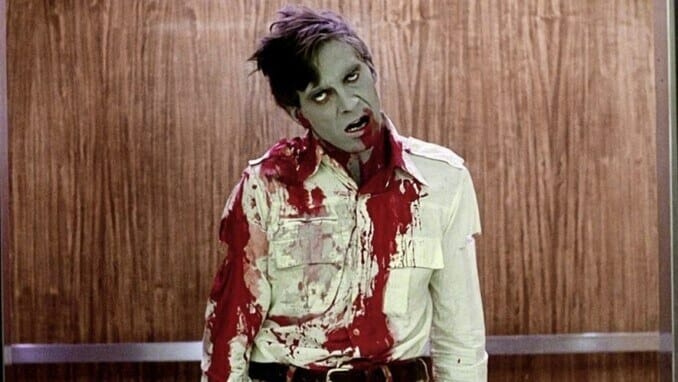
Here’s a film truism that everyone can agree upon: George Romero’s 1968 Night of the Living Dead is probably the most influential and important “zombie movie” of all time. It codified an entirely new meaning for the term, which is ironic, given that the word “zombie” never actually appears in the movie, where the creatures are typically referred to as “ghouls.” But regardless, NOTLD catapulted the Americanized idea of “zombies” far past their Haitian voodoo origins and into the cultural consciousness as dead bodies come back to life or otherwise reanimated, who fed upon the living. Few films in any genre can claim to be so influential. But is it the best zombie movie of all time? Or has it been surpassed by all the zombie movies of the last 50-plus years?
Despite its classic, definitive imagery, and despite everything it contributed to the history of horror cinema, it’s not as if Night of the Living Dead is a flawless film. It can be slow, a bit dated, and is limited by its minimal budget in more ways than one. With the historical record taken into account, it’s a great film. But it’s simply not the “greatest zombie movie of all time,” if we’re being objective.
What, then, even makes for a great zombie film? Are they determined more by great human characterization, or by the utilization of the zombies themselves? What’s more important: A unique setting, or great practical effects? Gore and mayhem, or wry social commentary? Black comedy, or genuinely frightening suspense? Each can make for valid, classic examples of zombie cinema. And please, let’s not debate what are and aren’t “zombies.” We all know that the “infected” of 28 Days Later aren’t Romero-style zombies, but the construction of the film is 100 percent a “zombie movie,” and it would be pointless to leave it off this list. Likewise with many other entries on the list—it’s about intent and presentation, not whether the creatures fit within a very specific guidelines.
So without further ado: Here are the 50 greatest zombie movies of all time. The list could easily have been longer, and we trimmed quite a few classics just to get down to 50. Will we reach 100 next year? Who’s to say?
50. White Zombie (1932)
Director: Victor Halperin
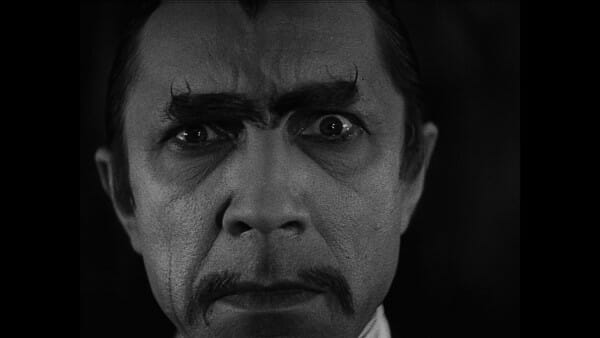
Where else could we begin? White Zombie was the first feature-length “zombie” horror film, and the first popularization of the Hollywood concept of Haitian voodoo zombies, decades before the modern George Romero ghoul. As a public domain staple in just about any cheapo package of zombie films ever assembled, it’s easy to find White Zombie today—you can simply breeze through its 67-minute runtime on YouTube, if you want. Bela Lugosi, only a year removed from Dracula and reveling in his celebrity as one of Universal’s go-to horror performers, plays a witch doctor, who is literally named “Murder” because the studio was still a few years away from discovering subtlety at this point. The Svengali-like Lugosi ends up using his various potions and powders to zombify a young woman who is engaged to be married, attempting to bend her to the will of a cruel plantation owner, and … well, it’s pretty dry, wooden stuff. Lugosi, predictably, is the one bright spot, but you had to start somewhere. After White Zombie, voodoo zombie flicks popped up occasionally in Hollywood for years, most of which are currently in the public domain today. And of course, the film also inspired a certain musical project from Rob Zombie. You’ll find it prominently on some “best zombie movie” lists, but let’s be real—this isn’t a film that most audience members would get much out of watching in 2016. It gets the #50 spot of honor almost solely for historical significance. —Jim Vorel
49. The Dead Next Door (1989)
Director: J. R. Bookwalter
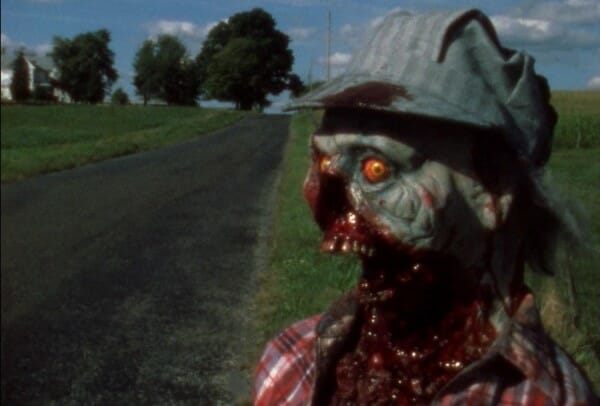
The story behind The Dead Next Door is one of those cases that is arguably more interesting than the film itself: It was produced by Sam Raimi, using a portion of the proceeds he’d made on Evil Dead II, to allow friend J. R. Bookwalter to direct the low-budget zombie epic of his dreams. Raimi, for whatever reason, is credited as an executive producer under the name “The Master Cylinder,” while Evil Dead’s Bruce Campbell pulls double duty—not on screen, but as a voiceover for not one but two characters, because the entire film has seemingly been redubbed in post. Unsurprisingly, this lends The Dead Next Door an air of dreamy unreality, and that’s before we’ve even mentioned that this film was SHOT ENTIRELY ON SUPER 8, rather than 32 mm film. What you have in The Dead Next Door, then, is something unique even for this genre: A grainy, low-budget zombie action-drama, featuring a combination of cringe-inducing amateur acting performances and touches of unexpected professionalism, all at once. The story revolves around an “elite team” of zombie exterminators stumbling on a zombie-worshiping cult, but you’re not watching this one for plot, you’re watching it for the gore. Seemingly made as an excuse to just practice blood effects and practical decapitations, The Dead Next Door sometimes feels like a backyard attempt to replicate the demented bloodletting seen in Peter Jackson’s Dead Alive, except with genre references that are so on-the-nose you can’t help but laugh. “Dr. Savini”? “Officer Raimi”? “Commander Carpenter”? They’re all here, in a zombie film that feels like it was never meant to be seen by anyone but the director’s family members. Still, there’s an odd charm in that level of shoddy intimacy. —Jim Vorel
48. World War Z (2013)
Director: Marc Foster

I really, really struggled with whether this film deserved to be included on such a list, but ultimately felt like I couldn’t deny it some kind of acknowledgement. The problem: World War Z is one of the worst adaptations of great source material that the horror genre has ever seen. Max Brooks’ 2006 book is a landmark piece of zombie fiction, notable for considering aspects of the zombie apocalypse that most authors would never even start to fathom, from “What happens to astronauts in the international space station?” to “Will it ever be possible to make root beer again, after the apocalypse?” The film, an in-name-only adaptation, chose to ignore that wealth of rich source material as too difficult to film, and instead tells a story about a UN investigator, played by Brad Pitt, jet-setting around the world in search of a cure or biological agent to fight the zombies. In telling its own story, it’s a somewhat interesting action-horror film, with a novel twist on the movement of its zombies, which pile up on each other and flow as a hive-like swarm of army ants. Still, it’s so hard to overlook all of the amazing individual stories from the World War Z source material and see them condensed down into a more by-the-numbers Hollywood blockbuster. The film’s main point of interest is its sheer budget and scale, which one rarely sees in modern zombie films, and that does provide a certain amount of novelty and value. If you were able to simply change the title to something other than World War Z, half of the grievances immediately drop away, and you’re left with a pretty serviceable, uniquely big-budget zombie epic. —Jim Vorel
47. Tombs of the Blind Dead (1972)
Director: Amando de Ossorio
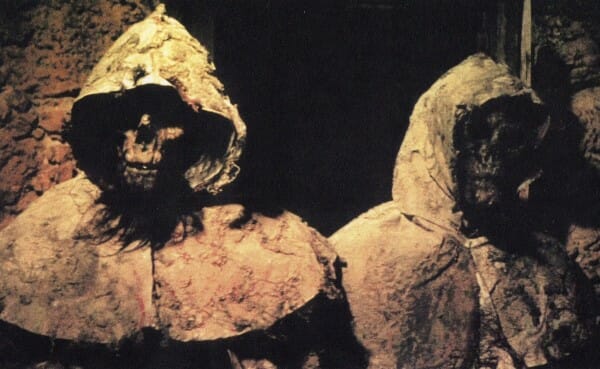
A young woman, riding a zombie horse, being pursued across a field in broad daylight by a bunch of sword-wielding Templar zombie knights, also riding zombie horses—that’s something that happens in this movie. Tombs of the Blind Dead was quite successful when released in its native Spain, a key film in that country’s early ’70s horror boom, in which restrictions on sexuality and violence loosened to be comparable to the giallo films of Italy. Director Ossorio questioned whether it should be considered a “zombie” film, as its revenants seem to be vampiric at times as well, but it’s really splitting hairs. The film follows some (quite dumb and impulsive) vacationers who end up in the abandoned ruins of the evil Templar monastery, awakening the blind dead, who can locate you by hearing your heartbeat. It’s a slow movie, and not quite on par with some of the Italian classics from Fulci and co., but is memorable for the great production design, sets and skeletal zombies, who, as I’ve already pointed out, ride freaking zombie horses. It also features a delightfully unexpected ending involving the slaughter of an entire train of innocent people. —Jim Vorel
46. Aaah! Zombies!, aka Wasting Away (2007)
Director: Matthew Kohnen
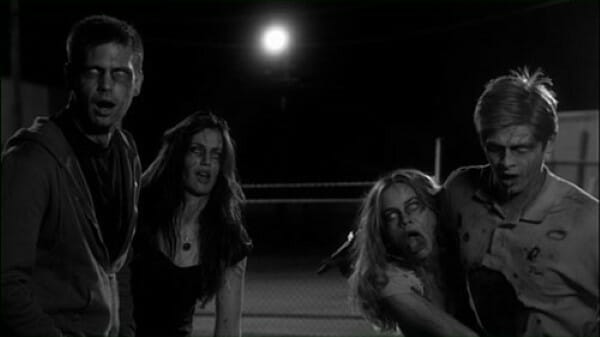
There’s no escaping that in the post-Shaun of the Dead era, indie zombie comedies piled up like so many bodies at the morgue after a zombie outbreak. Many of them are terrible, but occasionally you do get one like Aaah! Zombies! that is a pleasant surprise. The film uses a similar “told from the zombie’s point of view” structure to what you see in Colin, but with a clever, comedic twist: The zombies are conscious and unaware that they’re zombies. Rather, a group of slacker friends believe that they’ve become “super soliders” thanks to a confused military private who’s also become zombified. This is achieved through differing perspectives: When we see things from the zombies’ point of view, the film is colorized and their dialog is audible. When we see things from the perspective of human characters, the film is black-and-white, and the zombies are lumbering and uncoordinated. Our zombies, then, are something like unreliable narrators—we mostly see from their perspective, but we’re quickly made aware that their perspective is incorrect, which is the main source of humor. I’m making this film sound a bit more cerebral than it actually is, though—what one should expect from Aaah! Zombies! is simply some over-the-top slapstick humor, cartoonish zombie violence and silly character actor cameos. It gets a decent amount of mileage and laughs out of a decidedly indie budget. —Jim Vorel
45. Zeder (1983)
Director: Pupi Avati
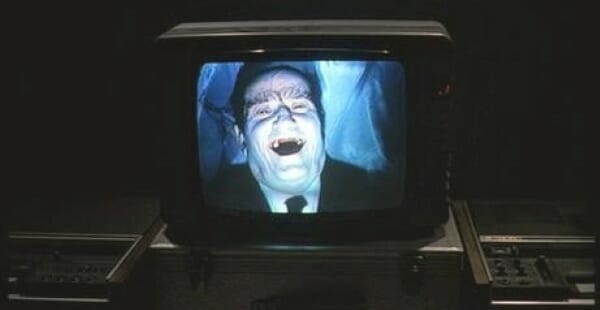
People who are casually acquainted with Italian horror cinema tend to know the greats—Lucio Fulci, Dario Argento, etc. But if you find a Pupi Avati disciple, then you know they’ve probably done their homework. Another horror and giallo director in the mold of Fulci or Bava, Avati’s most celebrated work is Zeder, a quite strange sort of horror-drama with another unique perspective on the idea of zombie movies. The film’s macguffin is the idea of “K-Zones,” which are mystically imbued places where, if you bury the dead, they’ll return to life. The problem is, there’s more than a little bit of Pet Sematary in this film’s DNA, and the dead come back to life with some serious attitude issues. In reality, it comes off a bit like a blend between Re-Animator and Pet Sematary, telling the story of a young novelist who is trying to unlock the mystery of the K-Zones and how they work, as if they’re Ra’s Al Ghul’s Lazarus pits in a Batman comic. It’s a well-shot, moody film that is light on the zombie gore and violence, but oddly memorable in its images. —Jim Vorel
44. Deadgirl (2008)
Director: Marcel Sarmiento
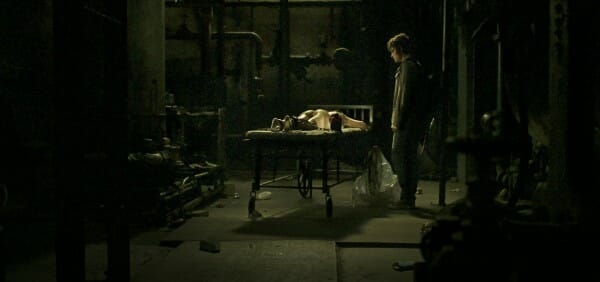
The 2000s was a decade of taboos falling, but zombie sex is still probably a bit much for many audiences. And yet, that’s pretty much the entire central theme of Deadgirl, certainly one of the most WTF zombie films that has come along in recent memory. You have to give it to the writers—no one had really drawn up an entire film about the sexuality of the undead before this. Unfortunately, it’s compulsory sexuality, as the “deadgirl” character in question is discovered by a handful of teenage boys, most of whom spend the majority of the film arguing over who gets to rape her next. The film wants to ask some kind of moral question about “what would you do?”, but considering that one half of the options involve necrophilia, the question doesn’t seem as complicated as the script would like it to be. The film is effectively creepy and gross, as you might imagine, and makes the list simply for suggesting an application for zombies that hadn’t been explored in this depth in the 40 years between this film and NOTLD. Like it or hate it, any and every instance of zombie sex in the future will always be compared to Deadgirl in some way. —Jim Vorel
43. Warm Bodies (2013)
Director: Jonathan Levine
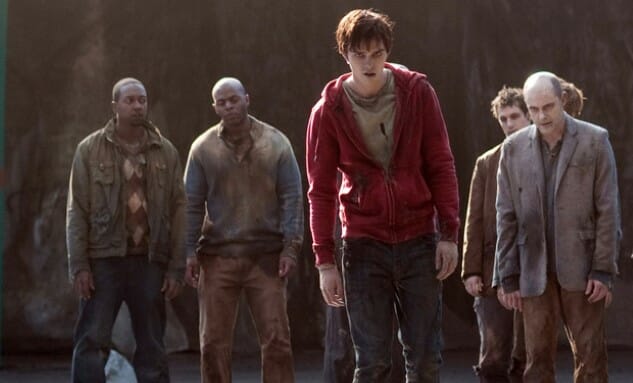
It would be easy to cast this Nicholas Hoult “rom-zom” film aside as simple teen fluff, but Warm Bodies is more entertaining than the serious horror geek might expect, and if your significant other isn’t so fond of exploding heads or people being torn apart in typical Romero-esque fashion, this film might be exactly what you’re looking for. Hoult plays “R,” a rather morose zombie whose days are spent endlessly wandering a defunct airport with hundreds of his brethren as the last vestiges of his humanity slip further and further from memory. That is, until he sees Julie (Teresa Parker) for the first time, and his cold, dead heart inexplicably begins to beat once again. What follows is something of a “Romero and Julie” situation, as we’re combining star-crossed zombies with the threat of Julie’s dictatorial father (a “I heard there was a paycheck here to be collected” John Malkovich).
Still, the best things in Warm Bodies aren’t necessarily the romantic aspects, but the amusing camaraderie between its characters. “R” has what amounts to a zombie bro, played by Rob Corddry, and their minimalistic, coworker-esque small talk is a highlight that is nicely integrated into the plot as the other zombies begin experiencing some of the same awakenings as “R.” Likewise, Julie’s own teenage existence in a heavily gated, walled survivalist community is the sort of thing you don’t often get a chance to see in more serious, horror-centric zombie fiction. All in all, Warm Bodies is a pleasant surprise that will appeal to the romantic comedy enthusiast and the zombie buff in equal measure. —Jim Vorel
42. Little Monsters (2019)
Director: Abe Forsythe
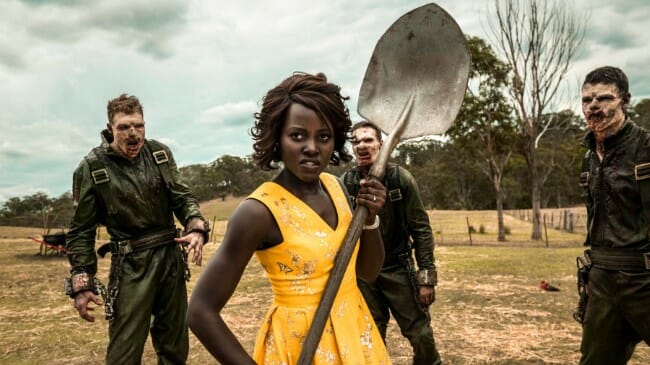
As Lupita Nyong’o was picking up her Academy Award for Best Supporting Actress in 2013, one probably wouldn’t have expected that she would be starring in not one but two different critically acclaimed horror films in 2019, but here we are. Most of the horror attention on Nyong’o was understandably derived from her scintillating turn in Jordan Peele’s Us, but Little Monsters feels sadly overlooked. This is a frequently uproarious zombie comedy, set in Australia, starring actor Alexander England as a slacker uncle to a precocious young child, and Nyong’o as the kid’s supremely dedicated and charming kindergarten teacher. And wouldn’t you know it—the class field trip to the farm/petting zoo just happens to be interrupted by a massive outbreak of the undead, leaving Nyong’o to shepherd her little flock to safety, all while concealing from them the seriousness of these events. She pulls off a performance that is both touching and generates the occasional belly laugh, while also showing off such a consistent talent for musical performance that you can’t help but wonder if the film was calculated as the launching point for yet another side career. Josh Gad also shows up as a children’s entertainer in a role that takes full advantage of his irritating talents, but the film really belongs to Nyong’o. —Jim Vorel
41. Dead Snow (2009)
Director: Tommy Wirkola

You’d be surprised just how many nazi zombie movies there truly are out there—the earlier mentioned Shock Waves may have been the first, but they’ve never stopped being made since, with the highest profile version from recent years being Dead Snow and its shark-jumping sequel, Red vs. Dead. The first Dead Snow, though no masterwork, is the better film because it at least partially tries to hit the horror audience instead of abandoning it for full-on horror-comedy camp. A group of students camp out in a remote, snowy cabin in Norway and unwittingly revive a regiment of Nazi zombies by appropriating their Nazi gold—pretty standard stuff for the genre. The attempts at humor and characterization are so-so, but the FX and action work are top-notch for an indie feature, with great costuming for the zombies and lots of explosive bloodletting, especially as it builds to a ridiculous conclusion. Go in with low expectations and just enjoy the blood ’n’ guts. —Jim Vorel
40. Nightmare City (1980)
Director: Umberto Lenzi
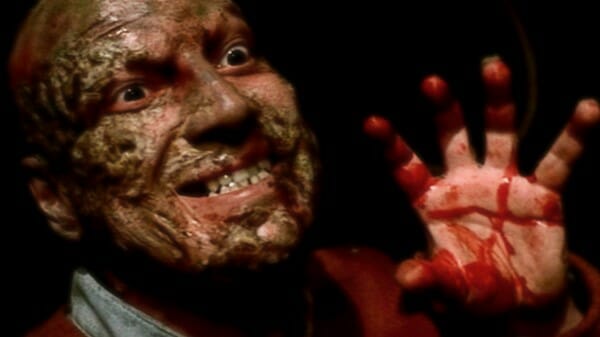
If you love ludicrous foreign horror cinema, and especially batshit crazy Italian zombie movies, then Nightmare City is like the holy grail of your subgenre. Because this movie is insane. Its zombies are irradiated and pizza-faced, with ridiculous makeup and a compulsion to drink blood like they’re vampires, because the radiation is destroying their own red blood cells. They’re unique for zombies in the sense that they retain some cognition—enough to pretend that they’re uninfected until they’re within range of people to kill. And oh, how they kill! These zombies are armed to the teeth with knives, axes, even machineguns. I repeat: This movie features machinegun-firing zombies, priestly zombies, doctor zombies and even zombies that are implied to have somehow flown and landed a large military plane on their own. Add to that a delightfully wacky English dubbing, full of awkward pauses, strange voices and philosophical ramblings, and you have the birth of a camp classic on your hands. Nightmare City stars Mexican actor Hugo Stiglitz (yes, the inspiration for the character in Tarantino’s Inglorious Basterds) as a rogue news reporter who races across the countryside with his wife, trying to evade the ghouls as she rambles continuous about the futility of the human experience. It all builds to one of the most laugh-out-loud conclusions you’ll ever see in a zombie film, and I wouldn’t dare spoil it. Suffice to say, Nightmare City is Euro-trash zombie cinema, but it’s GREAT Euro-trash zombie cinema for your next weird movie night. —Jim Vorel
39. 28 Weeks Later (2007)
Director: Juan Carlos Fresnadillo
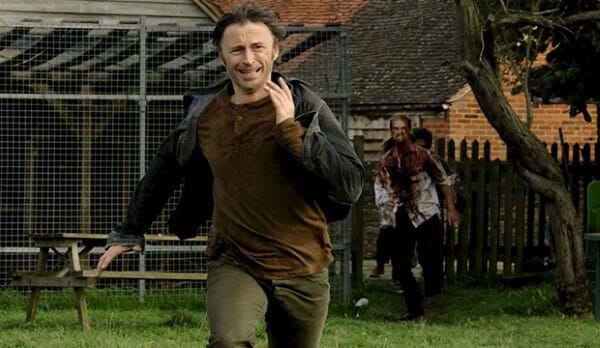
28 Weeks Later is an often interesting, often scary, often powerful and often frustrating film for zombie/horror genre geeks. As a sequel to 2002’s supremely influential 28 Days Later, it’s a partial success. It does a wonderful job of transplanting that film’s nihilistic, hopeless streak of terror and what one person is willing to do to survive—especially in the masterful opening scene, where Robert Carlyle’s character abandons his wife while fleeing from zombies in a soul-crushing chase across the fields of England as tears of guilt stream down his face. On the other hand, the film’s true main characters, his children, aren’t nearly as interesting—nor is the collection of military suits who have locked down England in the post-Rage virus cleanup. The film also violates one of the unwritten rules of zombie cinema, which is, “There shouldn’t be a ‘main zombie.’” In this case, when Robert Carlyle’s Don becomes infected and escapes, it hurts the story’s ability to be legitimately suspenseful, as we know the kids aren’t in any real danger during any of their encounters with the infected, because zombie Don is still unaccounted for. If the audience knows that the script will require this one infected person to be present for a conclusion, then it robs all the other infected of being perceived as legitimate threats. Still, despite all that, 28 Weeks Later is well-shot and full of shocking, gritty action sequences. It’s not without its flaws, but certain scenes such as the opener are so powerful that we’re willing to forgive a lot. —Jim Vorel
38. Blood Quantum (2019)
Director: Jeff Barnaby
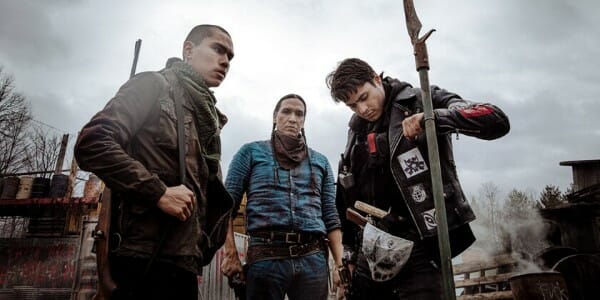
Jeff Barnaby’s Blood Quantum is a zombie film that strives for the satirical, political edge associated with the genre ever since Romero’s first foray into the realm of the living dead, and it sinks its teeth deep into the mundane evils of colonialism, with which the Mi?kmaq First Nation director is well familiar. Taking place in the early 1980s on the fictional Red Crow Indian Reservation, mirroring Barnaby’s own upbringing in Quebec, the setting captures the listless despondency of a place whose people have been slowly but surely robbed of their hope and resolve, as they’re thrust into a world where they’ll have to rediscover at least a modicum of it to survive. When the dead rise here, it doesn’t take long to notice who’s doing the rising—after genuinely disturbing imagery of animals such as gutted salmon returning to jerky, flopping life, it becomes clear that the white townies have all become the living dead, while the First Nation reservation dwellers are curiously immune. Ultimately, this results in a flipped power dynamic, in which the reservation becomes a guarded fortress and select whites are ushered in as refugees, to live or die by the whims of their native protectors … complete with inevitable hypocrisy, as the Orwellian transformation of “who’s in control” leads some of our protagonists down a dark path in which they embrace the worst aspects of colonialism for their own. Interspersed with beautiful (but too short) animated sequences that lend a little gravity to the proceedings, Blood Quantum stands out for a serious zombie portrayal largely unencumbered by comedy, with more than enough gore to satisfy the old-school horror junkie. It’s just subtly different enough to feel nicely fresh. —Jim Vorel
37. Slither (2006)
Director: James Gunn
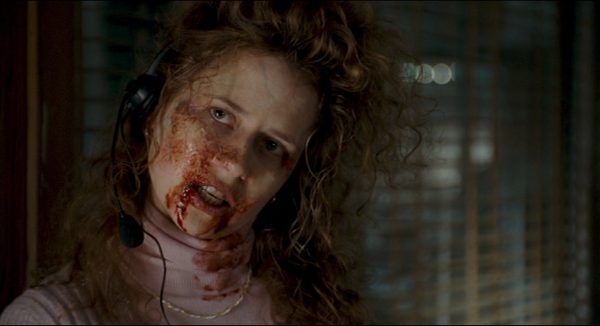
It’s funny to think that the director of a mega-smash like Guardians of the Galaxy got his start with a B-movie zombie/aliens homage, but that’s what James Gunn gleefully unleashed via Slither in 2006. It suffers just a little in terms of originality because the parallels are extremely obvious to another film on this list, 1986’s Night of the Creeps, but it’s a fun film in its own right. As in Night of the Creeps, the action revolves around a sort of alien parasite that arrives on Earth and unleashes a horde of parasitic slugs that turn the infected into what are essentially zombies. This time, however, the slugs are controlled by a leader—a sort of hive mind in the form of Henry: Portrait of a Serial Killer (and of course, The Walking Dead) veteran Michael Rooker, the philandering husband of Elizabeth Banks’ character. The casting is one of the strongest things the film has going for it, with Firefly’s Nathan Fillion in a hero role and an appearance from Jenna Fischer as well, only a year into The Office. Equal parts funny, gory, and very, very slimy, Slither never strives to be much more than sleazy entertainment. It knows its place and plays its role very well. —Jim Vorel
36. Let Sleeping Corpses Lie (1974)
Director: Jorge Grau

The U.S.A. is the first nation one tends to associate with zombie cinema, likely followed by Italy, perhaps followed then by countries such as Britain or Japan. Let Sleeping Corpses Lie, then, is an interesting outlier combining the resources of multiple film industries—it’s a Spanish-made zombie movie, filmed in Italy and set in England. In this one, the living dead are brought up from the ground by a “sonic radiation” machine designed to kill insects—the results, suffice to say, are not quite as intended. It’s an interesting mix of American zombie tropes and hard-to-place foreignness that moves a little slow but features some appreciably moody imagery. The zombies, however, look great, and the restored copy on Amazon Prime right now is a wonderfully high-quality version of the film in particular. It’s a somewhat underappreciated entry in the zombie annals that you won’t find in just anyone’s collection, but worth a look, especially if you’re into ’70s Spanish horror or want to branch out from the Italian zombie movies of directors such as Lucio Fulci. —Jim Vorel
35. Night of the Comet (1984)
Director: Thom Eberhardt
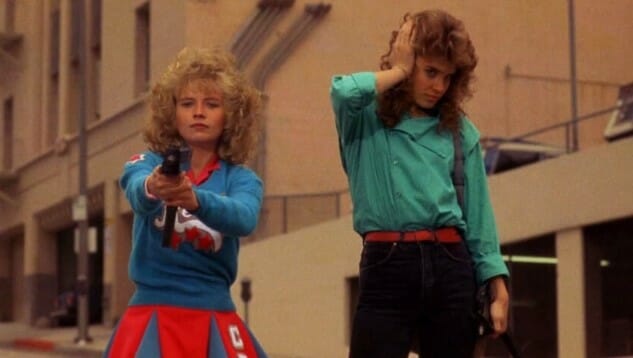
Night of a Comet is thoroughly B-movie in budget, but you can feel it yearning to be a bit more. It’s an able mash-up of ’50s and ’80s sci-fi tropes, all jumbled together and viewed through the lens of ’80s teen culture. When a comet passes close to Earth, exposure to some form of radiation literally vaporizes almost everyone on Earth, turning them to dust. Those few who got partial exposure instead become zombies, although this film is notable on a zombie list for being one of the least zombie-heavy. It’s a film that often feels like a big action scene is approaching, but never quite arrives. That’s not a criticism, as what you get instead is a character-driven, frequently funny, quirky little story with great art direction that evokes an abandoned Los Angeles. Protagonist Reggie in particular is like a parody of the ’80s nerd’s perfect woman—a gorgeous but overlooked girl obsessed with arcade game high scores, who also knows comic books better than her unappreciative doof of a boyfriend. In the end, it often feels like one of the several “everyone has disappeared” episodes of The Twilight Zone, except set in 1984. Odd tidbit: Co-star Kelli Maroney went on to appear in the very amusing Chopping Mall two years later in 1986, which also happened to feature her firing Uzis in a mall. —Jim Vorel
34. The Serpent and the Rainbow (1988)
Director: Wes Craven
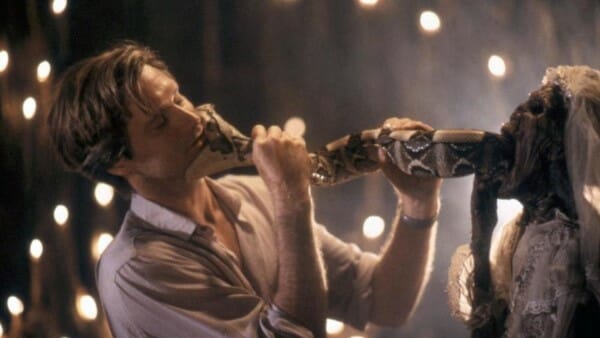
You can thank Wes Craven for an unexpected revival of the voodoo-style Haitian zombie in 1988’s The Serpent and the Rainbow, an unusual film based on the real-life accounts of an ethnobotanist who studied the roots of the zombie legend and the various potions and powders supposedly used to create “zombies” in Haiti. These are beliefs still accepted on some level in various communities today, but the film itself is far from grounded, and ventures into a rather outlandish caricature of voodoo beliefs. It makes for some memorable imagery—hairy monsters, victims being buried alive, waking up screaming; voodoo magic causing scorpions to materialize inside your throat; a man’s scrotum being nailed to a chair. (Wish I was joking on that last one, but I’m not.) The Serpent and the Rainbow is a pretty effective reminder of why films such as I Walked With a Zombie freaked people out so effectively more than 40 years earlier, and proof that it’s probably still possible to make a “voodoo zombie” movie that takes itself semi-seriously and aims to scare. —Jim Vorel
33. Juan of the Dead (2010)
Director: Alejandro Brugués
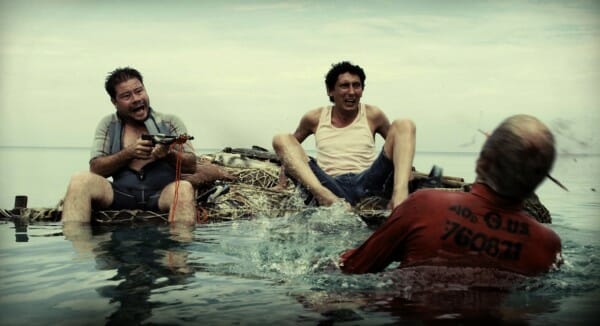
What is it about zombie films that compel small-time filmmakers to dream big? Juan of the Dead is billed as Cuba’s first feature-length zombie film, and it’s a remarkably confident piece of work from director Alejandro Brugués. It has some similarities with a more sober-minded Shaun of the Dead beyond the title—the main character is also a slacker with a slob of a best friend, but the tone is much more impoverished and street-level than the middle-class boredom of Shaun’s life. Juan of the Dead brings back some of the political verve to zombie cinema, with many Cubans assuming that the communist country’s zombie issues have something to do with “capitalist dissidents.” Juan, our hero, attempts to profit off the panic and confusion by starting an enterprising small business: For a fee, he and his crew will come to your home and dispose of your zombified loved ones. Of course, it eventually spins out of control, and his family and friends get wrapped up into the military’s larger fight against the zombies. It’s a well-balanced film that hits just enough horror, comedy and emotional notes, and one that raked in plenty of independent film awards. There are individual moments that distinctly recall George Romero’s films in a way that goes well beyond simple imitation. Juan of the Dead stands ably on its own. —Jim Vorel
32. I Walked With a Zombie (1943)
Director: Jacques Tourneur

I Walked With a Zombie is the second film overseen at RKO by producer Val Lawton, who produced a memorable run of low-budget but artful horror flicks in the early ’40s that included the likes of Cat People and The Ghost Ship. Far more atmospheric and less hokey than White Zombie, this film is a good example in general of the Hollywood system’s refinement from the early ’30s to early ’40s, even with its low budget. The story revolves around a young nurse who travels to the Caribbean to care for a patient who may or may not be affected by zombism, which draws her into a mystery surrounding a local voodoo cult. The cult’s zombie enforcer, Carre-Four, seen in the above photo, is one of the most iconic early images of a voodoo zombie, rocking the cliche “monster carry” pose of an unconscious woman. If only he was actually in the film more, it might be considered as a real classic today, but it’s still about as good as the voodoo zombie films of this time period get. There are some really spectacular individual shots in this film that chillingly play with intense shadows and the towering Carre-Four’s gaunt frame. I Walked With a Zombie might be the first historical zombie film with imagery likely to stick in your memory for years. —Jim Vorel
31. Land of the Dead (2005)
Director: George A. Romero
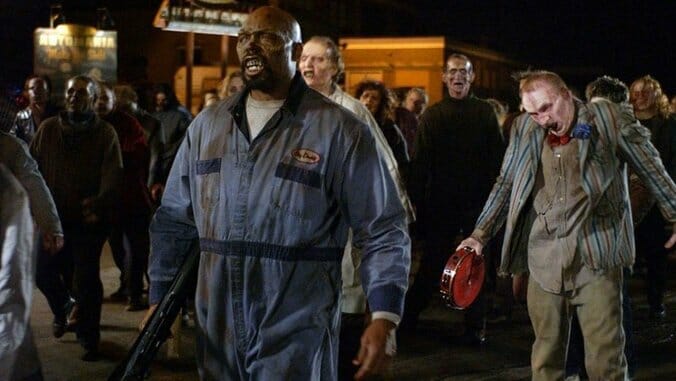
Land of the Dead is the last film in George Romero’s seminal zombie series that anyone is likely to recommend you seek out and watch. That isn’t to say that his following Diary of the Dead and Survival of the Dead are bad films, per se, but as Romero aged and the zombie genre became only more popular, he was no longer really able to offer a perspective that seemed truly unique and vital. Land of the Dead, thankfully, does build off the strength and continuity of his previous two films, Dawn and Day of the Dead, which helps it immensely in projecting the right tone. Chronologically, it’s the last Of the Dead movie, and it shows us the furthest extent of the zombies’ evolution in Romero’s eyes—whereas in Day of the Dead we discovered that certain zombies could “remember” and be trained, here we see more or less sentient zombies actually in leadership positions, leading the attack on a walled version of the city of Pittsburgh. Dennis Hopper, playing a perfectly Hopperian role, is the evil plutocraft ruler of said community, lounging in the luxury high-rise “Fiddler’s Green” while the rank-and-file live in squalor on the streets. Being Romero, you expect a certain degree of social commentary, and here he’s obviously tackling the wealth gap and class division, although it’s not quite as subtle in its delivery as his previous films. Still, the movie always LOOKS good, and it contains just enough of Romero’s rebellious spark to make it a worthy addition to the series. It’s not on the same tier as his first three films, but few zombie movies are. —Jim Vorel
30. Planet Terror (2007)
Director: Robert Rodriguez
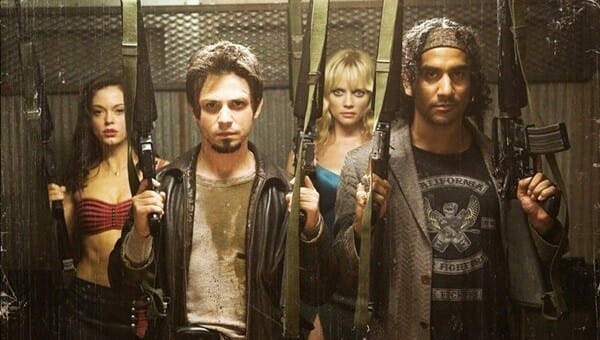
Planet Terror is what happens when someone sits Robert Rodriguez and Quentin Tarantino down in a room and says “Make a zombie movie. Make it goofy. No plot. Budget is not an issue. Have fun.” And so we got this film, one half of their combined double-feature Grindhouse, a yarn about destructive zombie/mutants created by a biological weapon to terrorize the southwestern countryside. Subtext? Social commentary? Robert Rodriguez laughs at these concepts. Planet Terror is just wanton, tasteless destruction in the name of fun, and it’s really good at being that kind of film. You’ve got a colorful cast of rogues with intersecting storylines, from Rose McGowan as the go-go dancer who ends up with a machinegun prosthetic leg, to the heroic Mexican drifter, to Josh Brolin as a sadistic doctor treating the outbreak. Hell, you’ve even got Michael Biehn from Terminator and a short Bruce Willis cameo, before they end up, you know … dead. Short on plot, the film quickly devolves into an all-out explosions-and-guts firefight, although the violence is all so comical and unrealistic that you’re not meant to take any of it seriously. The film is simply parody of cheap zombie movies, ironically done up with way more resources and effects than any of the movies it’s parodying. Both this and its attached brother film, Death Proof, deserved to make far more at the box office. How Grindhouse managed to make only $25 million box office, a month after 300, a film with roughly the same audience, made $456 million, I’ll never fully understand. But Planet Terror deserved better. —Jim Vorel
29. Cemetery Man (1994)
Director: Michele Soavi

Zombies, and really the horror genre in general, went through something of a lull in the 1990s, outside of genre-savvy offerings such as Scream. In Europe, though, unconventional zombie films did still pop up now and then, of which Cemetery Man is the most notable. The premise itself sounds old-school and spooky: A cemetery caretaker lives with his Igor-like assistant and kills the zombies that occasionally rise from their graves after being buried for 7 days. In reality, though, the film is essentially a horror art-comedy, an experimental and partially plotless, dreamy movie about the protagonist drifting through life without purpose and questioning why he bothers carrying out his duty. He pines after a woman who he immediately loses to zombification, and there are elements that almost remind one of American Psycho in the hopelessness and lack of identity he faces—even when the protagonist tries to commit atrocities and get caught, nobody seems to notice or care. It has the artistic flair and painterly quality of the earlier Italian films on this list, while incorporating some of the humor one might find in Re-Animator, but it’s moodier and more taciturn. It’s a film that tries to do many things at once, and is worth watching if only to shake your head as you consider the versatility of zombies, from simple flesh-eaters to complex symbols of entropy and nihilism. —Jim Vorel
28. 28 Years Later (2025)
Director: Danny Boyle
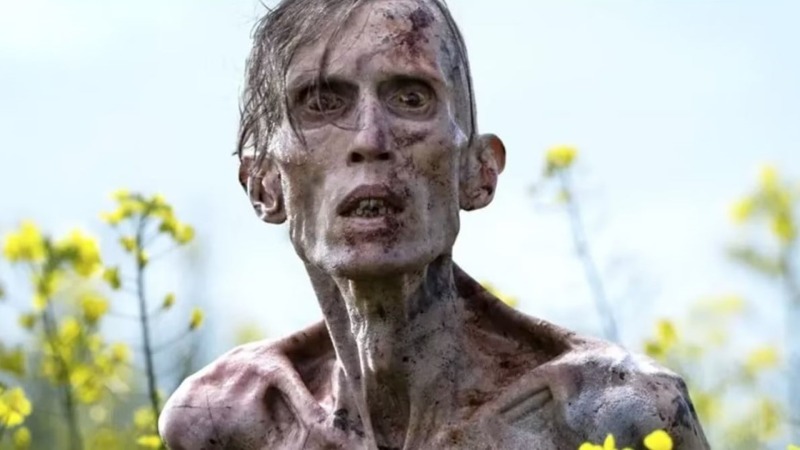
After such a long time away from Danny Boyle’s pioneering zombie/”infected” horror series, it’s natural to be not entirely sure what to expect from a concept like 28 Years Later, especially given its stated intention to be the first entry in an entire new trilogy. Even with that uncertainty, though, many audience members will no doubt end up being surprised, or shocked, by the film that Boyle has actually turned in here: A beautifully lyrical, almost surrealistic and fantastical venture into the pastoral beauty of the British countryside, where in the titular 28 years since the initial outbreak of the Rage Virus, said pathogen has diverged into an entire new and seemingly thriving species of infected former humans. This certainly isn’t the action-tinged horror film you might expect, although those elements are present in it: 28 Years Later‘s heart lays in a coming of age fable about confronting death and man’s impermanence in our world, complete with moving visual flourishes and whiplash-inducing tonal swings. At times profound, and soon after unabashedly silly, 28 Years Later is suffused heavily with Boyle’s unique mythic fingerprints, and it’s difficult to imagine how director Nia DaCosta is really meant to follow up with these same characters in sequel 28 Years Later: The Bone Temple, unless she completely ditches the style Boyle has refined here, a choice that would carry plenty of risks of its own. For now, though, we can simply appreciate the genuinely strange mixture of thrills, beautiful imagery and wackadoo structure that Boyle has cooked up in the long-awaited return of the series. —Jim Vorel
27. La Horde (The Horde) (2009)
Director: Benjamin Rocher, Yannick Dahan
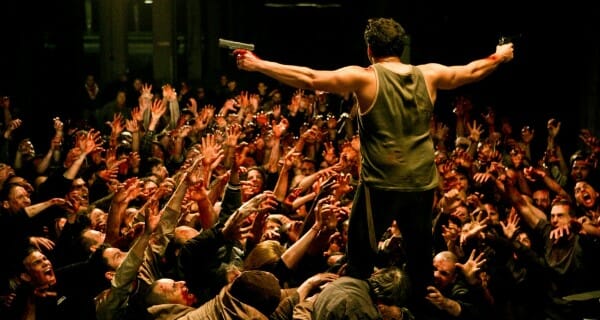
The Horde plays a bit like someone in France saw From Dusk Till Dawn and wondered what the format of that movie might be like with zombies instead of vampires. Like the Robert Rodriguez film, we get sucked into a tense crime story first, following a group of police officers as they storm a mostly abandoned apartment high-rise to take down a gang of drug dealers who killed one of their own. And then, 20 minutes in … a bunch of zombies arrive! You almost have to admire the total lack of foreshadowing—it’s a unique take on “the world has come to an end,” because in this story, the world comes to an end while the two sides (cops and drug dealers) are in the midst of a very pitched confrontation. They have no access to information on the wider world, and can only watch as Paris apparently tears itself apart. Naturally, the cops and robbers then need to team up in order to survive, in a strange mix of sadistic humor and emotional turmoil. As for the zombies, they actually look pretty awesome, although their abilities tend to vary wildly from scene to scene. An odd quirk: The zombies actually remove their own dead from the battlefield for reasons never fully explained, a trait I’ve never seen in another zombie movie. —Jim Vorel
26. Rammbock: Berlin Undead aka Siege of the Dead (2010)
Director: Marvin Kren

One of the coolest things about Rammbock is that it knows its own limitations and doesn’t attempt to stretch itself past the natural confines of its story. It’s an indie German “feature film” that is only 63 minutes long, but director Marvin Kren was right—it really doesn’t need to be a moment longer, and as a result it’s blissfully free from padding. The story revolves around Michael, something of a deluded sad-sack who was recently dumped by his girlfriend. His unannounced visit to “return her keys” just so happens to coincide with the citywide outbreak of a zombie virus, which leads to Michael and the various apartment/tenement dwellers being confronted with a wave of aggressive zombies pounding on their doors. In setting, one can’t help but compare it to a sort of zombie Rear Window, as the various residents converse and call back and forth to each other, or simply observe each other’s lives. We’re also given an unusual twist on zombie physiology—in this universe, mere infection doesn’t necessarily mean death and zombification. Rather, it’s possible to survive infection if emotions can be suppressed … but strong emotions will trigger the full transformation into a zombie. The very low budget is consistently apparent in the dull-looking visual palette and single location, but Kren gets the most out of his actors in a zombie movie that is also surprisingly gore-less. And at only 63 minutes, it never has to worry about overstaying its welcome. Rammbock is a lean, mean little zombie story that does just enough differently from the template to be memorable. —Jim Vorel
25. Zombieland (2009)
Director: Ruben Fleischer
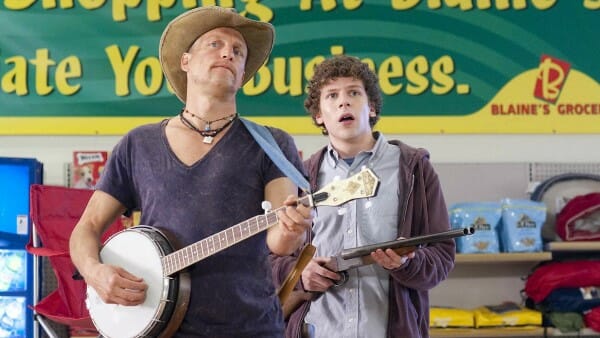
It feels like there’s a certain amount of blowback against Zombieland these days. Not among the general audience, where the film is still fairly well-liked, but among the horror and zombie geeks and “purists,” who don’t seem to consider it legitimate enough as a zombie film. I’m not sure why that is, in a genre where Shaun of the Dead is rightly hailed as the cream of the zombie comedy crop. Zombieland was certainly inspired on some level by the former, as it moved the action to the USA and brought together survivors who were anonymous to each other rather than a circle of friends, as in the tradition of NOTLD. Jesse Eisenberg’s Columbus is the type of character we hadn’t seen in a zombie film before, even in the comedies—somewhat neurotic, not particularly well-equipped to fight, but brainy and resourceful enough to get by on his own, he presents an entirely different mold of survivor. Of course it’s Woody Harrelson as Tallahassee who really steals the show, as a short-fused drifter on a seemingly pointless quest to find the world’s last box of Twinkies. Featuring zombies that are legitimately threatening, it tows a near-perfect line between comedic (but gory) violence and character-driven humor. —Jim Vorel
24. Night of the Living Dead (1990)
Director: Tom Savini
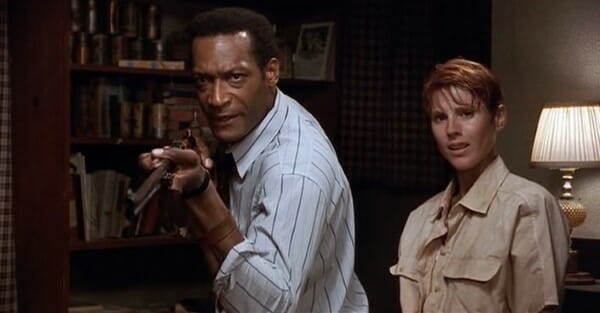
The 1990 remake of Night of the Living Dead by special effects maestro Tom Savini, who did the effects on Romero’s original films, never seems to get the attention or plaudits that it deserves. It’s understandable on one level—as the remake of a legendary movie, it had its work cut out for it, and this NOTLD truly is a faithful remake that didn’t try to reinvent anything in particular about the original film. Rather, this remake simply takes the classic story and transplants it accurately to a slightly more modernistic setting, with a bigger budget and better effects … and it’s good! NOTLD is timeless in its simplicity—a diverse group of strangers holed up in a house, under siege by zombies, without a clue of how such a terrible sequence of events has come to be. It’s hard to argue that the individual performances aren’t superior in Savini’s version, with the possible exception of replacing Duane Jones from the original with Tony Todd in the remake. But Barbara? The irritating Judith O’Dea is no loss as Barbara. Savini’s version also unsurprisingly features some sharp effects, delivering a much more visceral version of the same story that is more immediately accessible to a modern audience—although unfortunately, the goriest stuff ended up being cut by censors, which can make this movie feel oddly neutered at times. I can’t help but think, whenever I see this film, that if the title wasn’Night of the Living Dead it would be hailed as more of a classic of the genre. As a result, it remains underrated. —Jim Vorel
23. Dead & Buried (1981)
Director: Gary Sherman
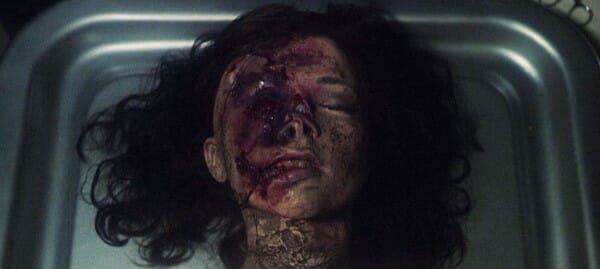
Dead & Buried is a thoroughly unusual horror film that revolves around the reanimated dead, but in a way all its own. In a small New England coastal town, a rash of murders breaks out among those visiting the town. Unknown to the town sheriff, those bodies never quite make it to their graves … but people who look just like the murdered visitors are walking the streets as permanent residents. The zombies here are different in their autonomy and ability to act on their own and pass for human, although they do answer to a certain leader … but who is it? The film is part murder mystery, part cult story and part zombie flick, and it features some absolutely gross creature work and gore from the legendary Stan Winston. It’s just a movie with a feel all its own, and one notable for some unusual casting choices. That includes a pre-Nightmare on Elm Street Robert Englund as one of the possibly zombified town locals, and, in a major role, Jack Albertson (Grandpa Joe from Willy Wonka) as the eccentric, jazz-loving town coroner/mortician, who steals every scene he’s in. More people should see this weird little film. —Jim Vorel
22. Wyrmwood: Road of the Dead (2014)
Director: Kiah Roache-Turner

It’s nearly impossible to discuss Wyrmwood without making the immediate and obvious Mad Max comparisons. Like George Miller’s seminal genre classic, this film arrives from a young Australian director with no shortage of style, but in addition to its car-focused post-apocalyptic leanings, the movie also features several other welcome twists on the zombie formula. You’d be forgiven for expecting yet another “gritty,” low-budget zombie film without any real ambition, but each minute propels Wyrmwood forward into unexpected territory, from the discovery that zombie blood can be used to power vehicles to the second-half revelations revolving around the character of Brooke and the development of latent psychic powers. The movie is many things at once: Scary without being dour, emotional without feeling pompous and gory without completely descending into the violent slapstick of Peter Jackson’s Dead Alive or Bad Taste. It features surprisingly compelling characters and develops them without relying on exposition—Brooke becomes one of the biggest stars of the film despite being a bound and gagged captive for almost an hour. In general, Wyrmwood: Road of the Dead is the kind of genre idea that many directors could have tackled, but few could have pulled off so stylishly or entertainingly on this kind of budget. —Jim Vorel
21. Handling the Undead (2024)
Director: Thea Hvistendahl
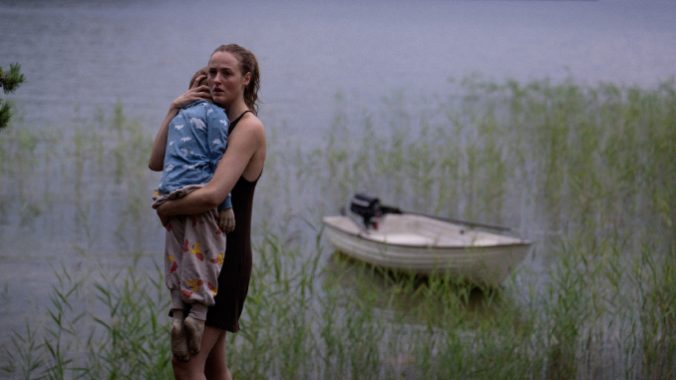
A zombie tragedy of false hope and brutal realizations, Handling the Undead adapts John Ajvide Lindqvist’s follow-up book to Let the Right One In with contemplative quiet. Director and co-writer Thea Hvistendahl positions three families afflicted by the sudden resurrection of a newly dead loved one as isolated units, staring in disbelief at the thing we’ve been trained since birth to avoid. A grandfather and mother care for a boy whose distended belly and unseeing eyes are like punishments inflicted upon them. An elderly woman jabbers away about her garden with the wife that walked back from her funeral. A comedian and his children ride an emotional roller coaster after his wife doesn’t stay dead after a car accident. Each is shot in strict compositions defined by straight lines, distancing angles and obscured frames. Hvistendahl’s lovely yet unnerving aesthetic is as cold and tangible as its corpses, paced with plenty of time for us to think. In this telling, the realities of death don’t go away with the unreality of revitalization, and the cannibalistic motivations that drive similar genre stories to crisis are avoided in favor of a creeping, omnipresent desperation. Where Let the Right One In‘s austere and icy vampire tale played more to our sympathies for its characters, Handling the Undead allows us to project our own fears and sadnesses onto its unaware zombies—just like those still living in its world. –Jacob Oller
20. The Battery (2012)
Director: Jeremy Gardner
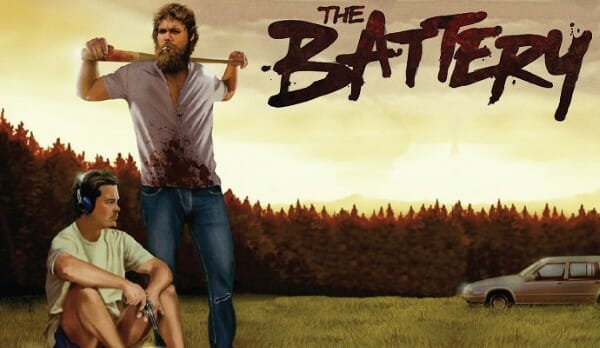
The concept of a low-budget zombie drama is one that has become fairly common in the 2010s, likely owing to the influence of The Walking Dead and games such as The Last of Us, which treated zombies or “infected” more like a set-piece to allow human drama to take shape. The Battery is an extrapolation of this format, a story about two men, a former baseball pitcher/catcher duo, traveling across the country together in the wake of a zombie apocalypse. And as for plot? That’s pretty much it. It’s a self-contained film that leans entirely on the performances of two actors, showcasing the ways that two men with vastly different personalities handle the mental strain and emotional challenges of continuing on each day and finding a reason to exist. The zombies are there, but they don’t really feel like active antagonists, as it were—they’re more like a constant roadblock and painful reminder of everything these men have lost in their former lives. It’s a film that almost mirrors the struggle of just getting out of bed in the morning to tackle another day—call the zombies your neighbors, your coworkers, etc. That’s what zombies have become today: A walking representation of 21st century ennui. —Jim Vorel
19. Night of the Creeps (1986)
Director: Fred Dekker
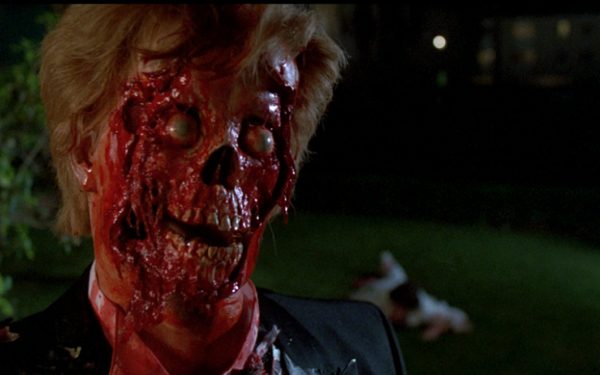
Night of the Creeps feels like a bastard child of both Return of the Living Dead (primarily) and Re-Animator tangentially, but it’s honestly a weirder film than either of them, and that’s saying something. Haphazardly blending sci-fi with horror-comedy, it’s about an invasion of parasitic alien slugs that turn their hosts into superpowered zombies. Directed by Fred Dekker, who would go on to helm the much more family-friendly Monster Squad a year later (which strangely enough, doesn’t have any zombies), it’s a risque, rather tawdry horror film set at a college, and thus often feels like some kind of zombified twist on Animal House. Like ROTLD, its inherent ’80s-ness is absolutely off the charts, but it has more of a science-y, lab-based feel thanks to the presence of aliens and a presumed plot to take over the world. In this way, it’s like the zombies were used to make the kind of ’50s-style B-movie that otherwise would have starred alien invaders. They took the monster of the decade, zombies, and substituted them into an earlier style of film, ramped up the sexualization and rock ’n’ roll, and a cult classic was born. —Jim Vorel
18. One Cut of the Dead (2017)
Director: Shin’ichirô Ueda
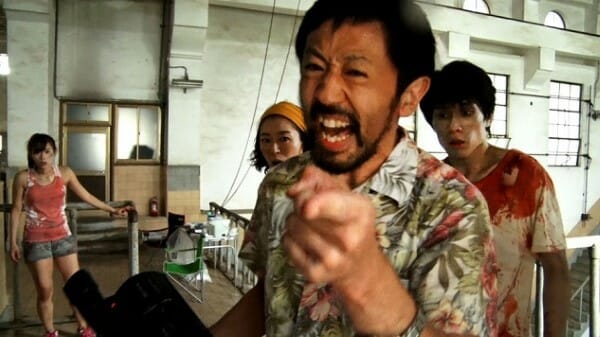
Director Shin’ichirô Ueda’s exceedingly clever backstage zombie comedy One Cut of the Dead has been dazzling Japanese genre fans in limited release ever since 2017, but it took a few years for the rest of the world to become aware of what a completely charming film we had been missing. The only thing that holds this particular entry back on a list of the “best zombie movies” is the fact that its zombies ultimately aren’t “real”—they’re actors attempting to produce a single-take, 30-minute long, live broadcast of a zombie short film, something the audience only realizes after the first third of the film has passed. It’s the rare case, though, of a story that gets exponentially funnier and more satisfying as it goes on, as it’s impossible not to get swept up in the shoestring, DIY spirit of the crew as they overcome a series of potential catastrophes behind the scenes of the 30-minute uninterrupted short film we’ve already witnessed. Everything that seemed odd or stilted about the short upon first inspection becomes a major source of humor in the backstage segments, building to a conclusion in which the sense of joy in having somehow achieved the impossible feels entirely earned. It may not be a “zombie movie” in the most literal sense of the words, but One Cut of the Dead poignantly captures the creative spirit and adaptability displayed by low-budget filmmakers like George Romero when they were birthing the genre in the U.S. —Jim Vorel
17. The Plague of the Zombies (1966)
Director: John Gilling
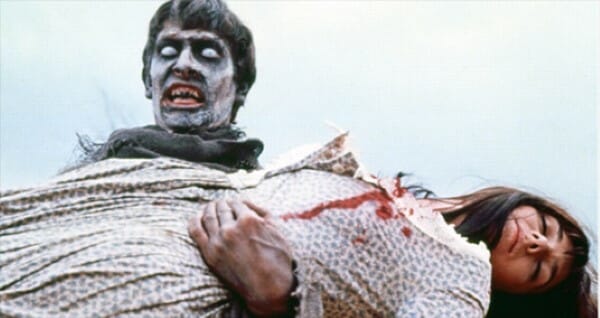
Revivals of the classic Universal monsters (Dracula, Frankenstein, The Mummy) were the main forte of Hammer Horror, but the British studio also managed to produce one great, influential zombie movie that has flown pretty much under the radar in the decades since its release. Plague of the Zombies does feature voodoo zombies, but they’re not quite the same as those early B&W examples. Decayed-looking and truly frightful, with a fantastic design aesthetic, they feel like a true bridge to the Romero ghoul, and the visual influence on Night of the Living Dead is pretty obvious. Featuring great production design and a spooky story about a town slowly wasting away via a plague of zombism, it’s one of my favorite pre-Romero zombie films, and one that deserves a significantly larger audience. With its glorious Technicolor imagery, it fits in comfortably alongside the better-known Hammer classics from Terence Fisher. You can also include visually similar films such as Vincent Price’s The Last Man on Earth as Romero-influencers, but the creatures in that film are much closer to vampires than they are zombies. —Jim Vorel
16. Braindead, aka Dead Alive (1992)
Director: Peter Jackson
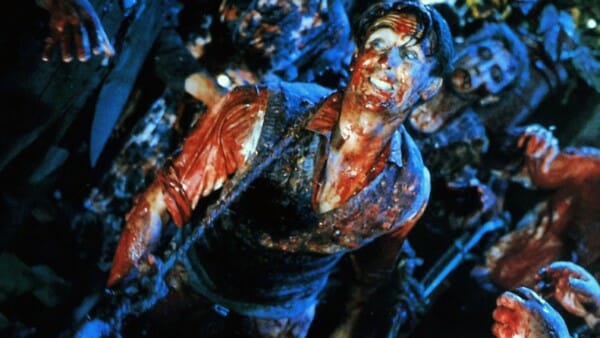
If you’ve ever wondered to yourself about the record holder for “bloodiest film ever made,” then Dead Alive at least has to be in the conversation. A New Zealand horror-comedy by eventual Lord of the Rings helmer Peter Jackson, it’s basically the Evil Dead 2 formula taken as far and as lurid as it could possibly go. A bite from a “Sumatran rat monkey” turns the protagonist’s mother into a mutating zombie, and things simply snowball from there as various visitors and townspeople are infected and turn into rampaging beasts who have to be dispatched via absurd, comedic ultraviolence. This is not a film for the squeamish or faint of heart, even though the gore is presented in a way meant to simultaneously elicit laughs and “ewwwss.” Released in its native country as Braindead and as Dead Alive in the United States, this can be considered one of the crowning achievements of the gross-out zombie comedy. Practical effects just don’t get any ickier, slimier or bloodier than this, especially in the epic, iconic final confrontation between the hero, a room full of zombies and a remarkably gore-resistant lawnmower. How that lawnmower keeps functioning when choked with 1,000 gallons of blood, I’ll never know. —Jim Vorel
15. Dawn of the Dead (2004)
Director: Zack Snyder

Is it any surprise that Zack Snyder’s best film is his least “Zack Snydery”? On one level, you could call it a safe box office call to remake one of the most beloved zombie stories of all time, but at the same time, Snyder tackled that property in a pretty ambitious, risky way. Unlike Savini’s Night of the Living Dead, this isn’t a tribute and homage that faithfully is attempting to recapture the spirit of the original. Snyder’s Dawn of the Dead is an entirely different beast, trading much of Romero’s cultural commentary for a leaner, action-packed, grisly modern zombie tale. It’s extremely indebted to 28 Days Later, which serves as obvious inspiration for the ghouls themselves. At the time, its “fast zombies” were hailed as revolutionary, if only because it brought the sprinting ghoul to the official Romero Family universe. But the running zombies are indicative of the film’s high-strung energy and vitality, which kicks into high gear immediately with one of the best opening sequences in zombie film history. This truly is a world that goes completely to hell overnight, as Sarah Polley’s character Ana falls asleep and wakes up in the morning, finding all of civilization crumbling around her in an orgy of blood. The survivors we assemble at the mall are well-chosen, especially security guard C.J., who is presented as the principal “human antagonist” early on but then actually goes on to completely redeem himself over time. Such measurable character growth is profoundly unusual for this genre. —Jim Vorel
14. Train to Busan (2016)
Director: Yeon Sang-ho
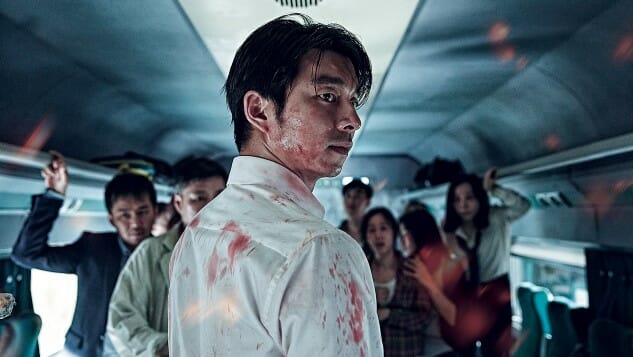
For a genre that has been run into the ground at times in recent years, there does tend to be at least one great, independent zombie movie in any given year, and in 2016 that movie was Train to Busan. Derided unfairly by some as “Snowpiercer with zombies,” this South Korean story of a career-minded father attempting to protect his young daughter on a train full of rampaging zombies is equal parts suspenseful popcorn entertainment and genuinely affecting family drama, without Snowpiercer’s sheen of comic book social satire. It concludes with several action elements that I’ve never seen before, or even considered for a zombie film, and any time you can add something truly novel to the genre of the walking dead, then you’re definitely doing something right. With a few memorable, empathetic supporting characters and some top-notch makeup FX, you’ve got one of the best zombie movies of the past half-decade. —Jim Vorel
13. The Beyond (1981)
Director: Lucio Fulci
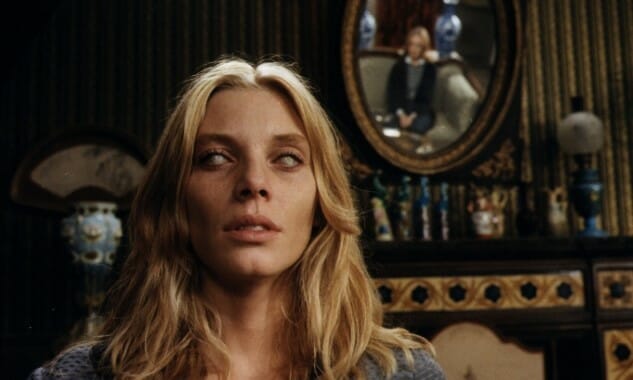
It’s hard to describe Fulci’s The Beyond in absolutes. Some would contend that it isn’t a “zombie movie.” Which isn’t to say there aren’t any zombies in it, but it’s not a Romero-style zombie movie, as Fulci pulled off in Zombi 2. The Beyond is the middle entry in Fulci’s “Gates of Hell” trilogy, and takes place in and around a crumbling old hotel that just happens to have one of those gates to hell located in its cellar. When it opens, all hell starts to break loose in the building, in a film that combines a haunted house aesthetic with demonic possession, the living dead and ghostly apparitions. As with so many of the other films in this mold, it’s not always entirely clear what’s going on … and honestly, the plot is more or less irrelevant. You’re watching it to see zombies gouge the eyes out of unsuspecting innocents or watch heads being blown off, and there’s no shortage of either of those things. Thinking back to Lucio Fulci movies after the fact, you won’t remember any of the story structure. You’ll just remember the ultra gory highlights, splattering across the screen in a way that continues to influence filmmakers to this day. Modern horror films such as We Are Still Here show heavy inspiration from Fulci, and The Beyond in particular. It’s one of the most stylish of the Italian, zombie-featuring horror flicks. —Jim Vorel
12. REC (2007)
Director: Jaume Balagueró and Paco Plaza

2007 was a breakthrough year for post-Blair Witch found-footage horror, including the first Paranormal Activity and Romero’s own Diary of the Dead, but it wasn’t only in the U.S. that people were effectively employing that technique. The best of all the found-footage zombie films is still probably REC, another film on this list that exhibits some playfulness in redetermining exactly what a “zombie” is or isn’t. The Spanish film follows a news crew as they sneak inside a quarantined building that is experiencing the breakout of what essentially appears to be a zombie plague. The fast-moving infected resemble those of 28 Days Later and are later revealed to be demonically possessed in a way that moves through bites, ably blending traditional zombie lore and religious mysticism. It’s a capable, professional-feeling film for its low budget, and there are some excellently choreographed scenes of zombie mayhem that feel all the more claustrophobic for being filmed in a limited, first-person viewpoint. Zombie horror seems to go hand-in-hand with the found-footage approach more naturally than some other horror genres—perhaps it’s the fact that in the digital age, we’d all be compelled to document any such outbreak on our phones or other devices? Regardless, it’s not nearly so forced as some entries in this particular horror subgenre, and gives an excellent sense of what it might be like if you were just an average person locked in a huge apartment building filled with zombies. —Jim Vorel
11. Pontypool (2008)
Director: Bruce McDonald
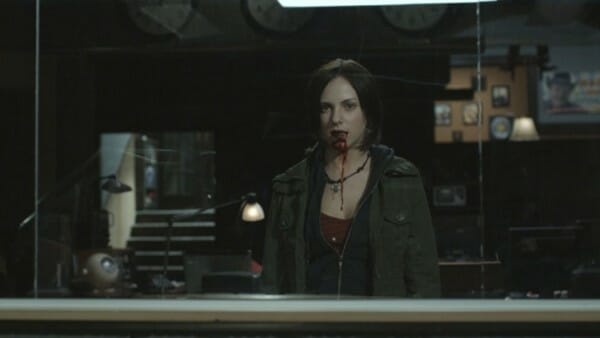
Pontypool is one of the most cerebral and ethereal re-imaginings of what the word “zombie” might be taken to mean, and it’s a film that I respect immensely for taking the hard road. Zombie fans (and horror fans in general) are a fickle bunch—we want things we haven’t seen before, but we also want our films to reflect everything in the history of the genre, which is a near-impossible task. Pontypool doesn’t bother at all with zombie convention. Rather, its antagonists, which are never called “zombies” and are occasionally referred to as “conversationalists” by director Bruce McDonald, are a criticism of 21st century humanity’s inability to truly connect and discuss pertinent, truly significant issues. There is indeed a “zombie virus” here, but it’s not transmitted through bites or blood, but by ideas, by the very English language, which has become so watered down with pleasantries and insincerity that it’s taken on a destructive life of its own. The film ultimately contains all of the gore and violence you would expect from a great indie zombie film, simply delivered in a unique way, with a distinctly new message. It’s a truly postmodern zombie film and deeply dissatisfied jab at society itself. —Jim Vorel
10. Demons (1985)
Director: Lamberto Bava
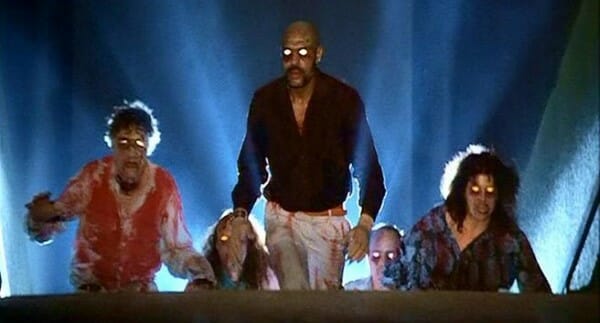
Demons is the best zombie film ever made that entirely pretends to be about a different type of monster. Because, let’s be clear, the creatures in Demons are 100 percent zombies, and it’s a near-perfect example of a “zombie movie”—there might be no other film on this list that is closer to the structure of Night of the Living Dead than Demons. The action all takes place in an opulent old movie palace, the perfect location to bring together a large cast of weirdo characters—from preppy kids to arguing lovers, a pimp with his prostitutes and even a blind man who is simply listening to the film. Unfortunately, they all fall prey to an outside plot, as mysterious forces have orchestrated both the showing of a shocking horror film and the outbreak of a plague of zombification/demonization among the people in the audience. What follows is a meat grinder of ’80s practical effects violence and survival, as the audience members still alive barricade themselves into the balcony and attempt to mount an escape. The story is as simple as it gets, but the outstanding zombie/gore effects, corny characters and “who will survive?” mystery propel it to classic status. Plus, you’ve got to love a horror movie that suggests you might get killed simply because you attended a horror movie. —Jim Vorel
9. Zombi 2 (1979)
Director: Lucio Fulci
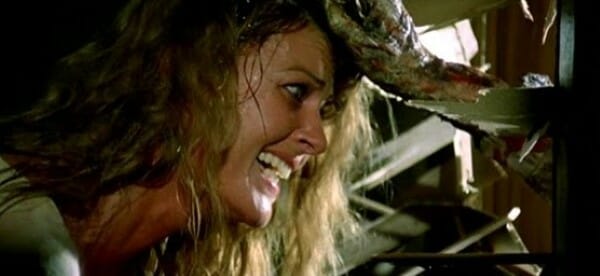
In the ’70s and ’80s, it was hard to beat Italy in terms of fucked-up horror movie content, and given that market’s fondness for the “cannibal film,” is it any surprise they also came to love the zombie genre as well? Zombi 2 is the crown jewel of all the Italian zombie movies, cleverly implied as essentially a direct follow-up (thematically, not plot-wise) to Romero’s Dawn of the Dead, which had been released in Italy to great success under the title Zombi. Helmed by Italian giallo/supernatural horror maestro Lucio Fulci, Zombi 2 significantly upped the crazy factor and pushed gore to a new ceiling. The effects and makeup on this film are absolutely disgusting, and it’s filled with iconic moments that have transcended the horror genre. Scene of someone having an eye poked out? They’re always compared to the eye-poking scene in Zombi 2. Scene where a zombie fights a freaking SHARK? Well, nobody compares that, because nobody has the balls to try and one-up Zombi 2’s zombie shark-fighting scene. That’s one contribution that will stand the test of time. Zombi 2 has had countless foreign imitators since, but none of them can measure up. —Jim Vorel
8. Night of the Living Dead (1968)
Director: George A. Romero
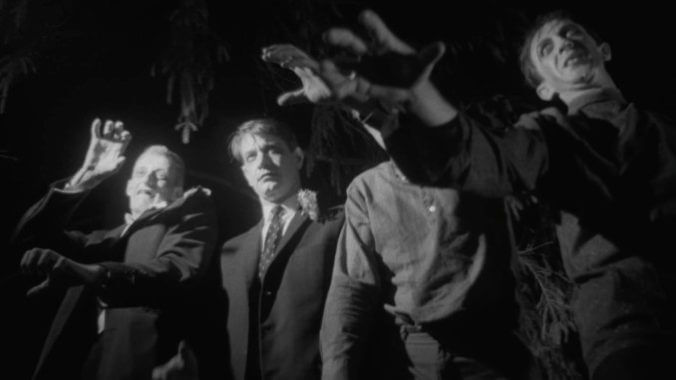
What more can be said of Night of the Living Dead? It’s pretty obviously the most important zombie film ever made, and hugely influential as an independent film as well. George Romero’s cheap but momentous movie was a quantum leap forward in what the word “zombie” meant in pop culture, despite the fact that the word “zombie” is never actually uttered in it. More importantly, it established all of the genre rules: Zombies are reanimated corpses. Zombies are compelled to eat the flesh of the living. Zombies are unthinking, tireless and impervious to injury. The only way to kill a zombie is to destroy the brain. Those rules essentially categorize every single zombie movie from here on out—either the film features “Romero-style zombies,” or it tweaks with the formula and is ultimately noted for how it differs from the Romero standard. It’s essentially the horror equivalent of what Tolkien did for the idea of high fantasy “races.” After The Lord of the Rings, it became nearly impossible to write contrarian concepts of what elves, dwarves or orcs might be like. Romero’s impact on zombies is of that exact same caliber. There hasn’t been a zombie movie made in the last 47 years that hasn’t been influenced by it in some way, and you can barely hold a conversation on anything zombie-related if you haven’t seen it—so go out and watch it, if you haven’t. The film still holds up well, especially in its moody cinematography and stark, black-and-white images of zombie arms reaching through the windows of a rural farmhouse. Oh, and by the way—NOTLD is public domain, so don’t get tricked into buying it on a shoddy DVD. —Jim Vorel
7. Evil Dead 2 (1987)
Director: Sam Raimi
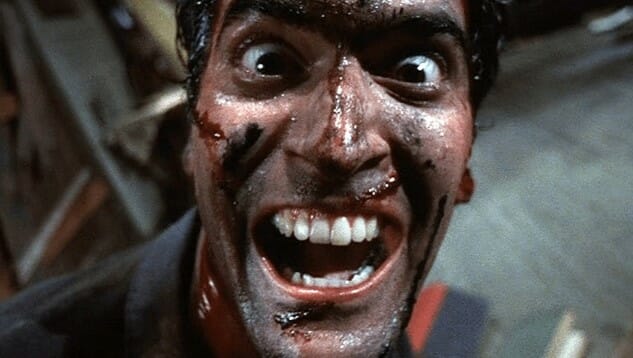
The obvious question to answer here is not whether Evil Dead 2 is great or whether it’s influential, but if it qualifies as a “zombie movie,” per se. The deadite antagonists are magically or demonically empowered—their bodies are inhabited, whether they’re alive or dead. The fact that many of them are reanimated corpses, though, makes me say it’s close enough—you can call them “zombies,” at least on some level, and the rural farmhouse location is almost exactly the same as in NOTLD. The film is essentially a remake of the first 1981 Evil Dead; Sam Raimi going back to an idea he clearly enjoyed with a bigger budget and more experience to “get it right” and up the ante. There are some tweaks—Ash goes from being almost a “final girl” character to a much more capable, wisecracking one right from the get-go, and significantly more of the film features him in a tour-de-force solo performance, which helps make Evil Dead 2 one of the best, most tightly paced horror comedies ever. It just wastes no time, going straight into the insanity and comic violence within the first 10 minutes and never letting up ever again. It’s a film indicative of the changing attitude toward zombies—at this point in the late ’80s it’s becoming rare that zombies are ever treated as simply “scary.” More and more frequently, they’re instead incorporated into madcap comedies and action films à la Evil Dead, and this is a trend that continued through the ’90s. —Jim Vorel
6. Shaun of the Dead (2004)
Director: Edgar Wright
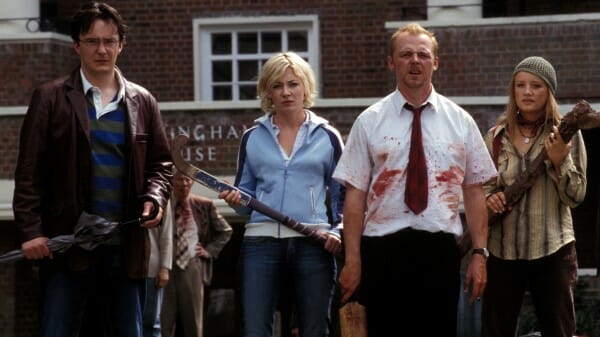
Together, 28 Days Later and Shaun of the Dead established precedents for the “modern” zombie film that have more or less continued to this day. The former made “zombies” scary again, and the latter showed that the cultural zeitgeist of zombiedom (which was picking up around this point) could be mined for huge laughs as well. Most importantly, the two types of films could exist side by side. Shaun of the Dead makes a wry, totally valid criticism of modern, digital, white-collar life through its wonderful build-up and tracking shots, which show slacker Shaun wandering his neighborhood failing to even realize that a zombie apocalypse has happened. Once he and his oaf of a friend finally realize what’s happening and take up arms to protect their friends and loved ones, the film becomes a fast-paced, funny and surprisingly emotional action-comedy. Few horror comedies have actually combined the elements of humor and serious horror the way this one does in certain scenes—just go back and watch the part where David is dragged through the window of The Winchester by zombies and literally torn to pieces. It’s a film that works on so many levels, and manages to be uproariously funny while still being quite faithful to the fidelity of Romero-style zombies. Much in the same way as Zombieland (a definite spiritual successor), it shows that whether the zombies are “scary” is ultimately a matter of how everyone reacts to them. Shaun of the Dead was so momentous that it’s next to impossible to make a zombie comedy at this point without being accused of ripping it off—take Fido, a film that seems based entirely on the “domesticated zombie” gag at the end of this film. —Jim Vorel
5. Day of the Dead (1985)
Director: George A. Romero
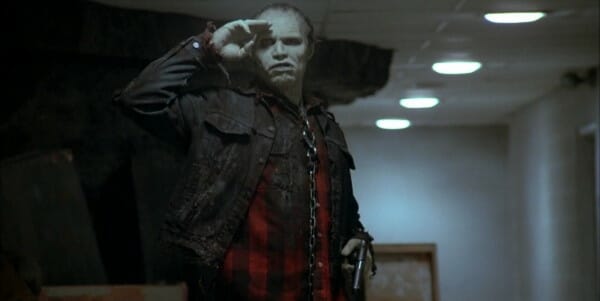
Although Dawn will probably always have more esteem, and is significantly more culturally important, Day of the Dead is my personal favorite of George Romero’s zombie films, and I don’t think it ever quite gets the respect it deserves. It comes along at a sort of sweet spot—bigger budget, more ambitious ideas and Tom Savini at the zenith of his powers as a practical effects artist. The human characters this time are scientists and military living in an underground bunker, which for the first time in the series gives us a wider view of what’s been going on since the dead rose. This film reintroduces the science back into zombie flicks, finally making one of the main characters a researcher (Matthew “Frankenstein” Logan) who has had some time to study the zombies in the relative safety of a lab. As such, the movie redefines the attributes of the classic Romero ghoul—they’re dumb, but not entirely unintelligent, and some of them can even be trained to use tools and possibly remember certain aspects of their previous lives. That of course brings us to “Bub,” maybe the single most iconic zombie in Romero’s oeuvre, who displays a unique level of personality and even humor. Day of the Dead ultimately takes a monster that audiences thought they knew pretty well at this point and suggests that perhaps they were only just scratching the surface of zombies’ potential. —Jim Vorel
4. 28 Days Later (2002)
Director: Danny Boyle
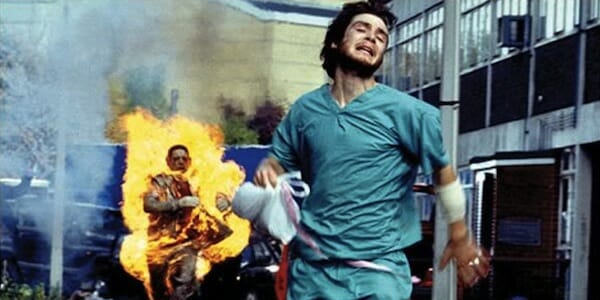
The classical zombie film was effectively dead by the time 28 Days Later came along in 2002 and completely reanimated the concept. (And YES, we all know that the “infected” in this film aren’t technically zombies, so PLEASE don’t feel that you have to remind us of this in the comments.) The definition of “zombies” is fluid, and always expanding. Here, they’re living rather than dead, poor souls infected by the “rage virus” that makes them run amok, tearing through whatever living thing they see. It’s a modernization of the same fears that powered Romero’s ghouls—unthinking assailants who will stop at nothing and are now more dangerous than ever because they move at a full-on sprint. It’s hard to overstate how big a quantum leap that mobility was for the zombie genre—the early scenes of 28 Days Later where Cillian Murphy is trying to navigate a deserted London in hospital scrubs and is being chased by fast-moving zombies did for this genre what Scream did for the slasher revival, sans the humor. Indeed, 28 days Later is a dead-serious horror film, and also marked a return to seeing these types of creatures as a legitimate, frightening threat. It’s indicative of another trend of the 2000s, which was to reimagine the classic rules of zombie cinema to fit the needs of the film. The Zack Snyder Dawn of the Dead remake replicated a lot of this film’s DNA when it was released two years later, although it marries the concept with the more traditional Romero ghoul. Together, those two movies gave birth to the concept of the 21st-century serious zombie film. —Jim Vorel
3. Re-Animator (1985)
Director: Stuart Gordon
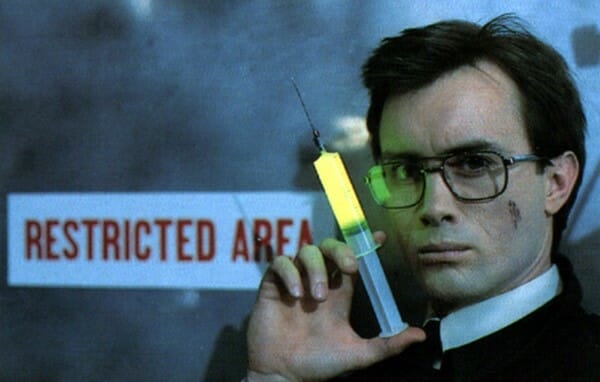
Day of the Dead brought a science aspect to reanimated corpses, but Re-Animator revels in it. This is the best kind of pulpy science, the stuff that one would have found in the pages of Weird Tales in the heyday of H.P. Lovecraft. And indeed, Re-Animator is a modernized Lovecraft adaptation from a 1921 story, still perhaps the best adaptation made from one of his pieces of short fiction. Jeffrey Combs shines in a wonderfully manic, campy portrayal of mad scientist Herbert West, who brings the dead back to life via syringes of glowing green ooze. Only problem? They freak out immediately after coming back to life and try to murder everything around them, which naturally doesn’t stop West from trying over and over and over again in the film’s lesser sequels—although the first, Bride of Re-Animator is decent and narrowly missed this list. Re-Animator contains a streak of the black humor that would begin appearing regularly in zombie films from this point onward, even though its gore and scenes of violence are quite horrific as well. It feels like a reaction by forward-thinking director Stuart Gordon to genre fans who had started becoming desensitized to the staid atmosphere of sincere horror films and wanted to laugh at gory zombie violence rather than simply recoil from it. —Jim Vorel
2. Return of the Living Dead (1985)
Director: Dan O’Bannon

John Russo is a huge unknown in terms of important figures in the history of zombie cinema, at least among those who aren’t big horror geeks. Russo is the man who created the original story for Night of the Living Dead alongside George Romero, and thus is essentially one half of the driving force for the most famous zombie film of all time. After the two parted ways post NOTLD, their settlement dictated that Russo would retain the rights to any future films with the phrase “living dead” in the title. Thus, Romero’s “of the dead” monikers in future films. Russo, meanwhile, instead wrote his sequel as a novel, which as then finally adapted as a film 17 years after the original NOTLD with extensive rewrites by director Dan O’Bannon. The result is one of the all-time zombie classics, a film that is equal parts gory and hilarious while making a concerted effort to capture the youth movement, art aesthetic and especially music of the mid-’80s. It’s influential in so many different ways: the comedic tone; the youth focus; the scapegoating of an American military experiment gone wrong as the genesis of the zombies. The zombies too have been completely redesigned with all-new capabilities—they’re intelligent; they can speak; they can move fast; and for the first time ever, they’re specifically targeting human brains. That last point was so influential and so ubiquitous in the genre after 1985 that it’s incorrectly been assumed by many people for decades that the Romero zombies are brain-eaters. For these reasons, ROTLD is undoubtedly one of the most significant zombie films ever. And by the way—with ROTLD, Day of the Dead, Demons and Re-Animator all being released in 1985, is it safe to say this was the greatest year in the history of zombie cinema? —Jim Vorel
1. Dawn of the Dead (1978)
Director: George A. Romero
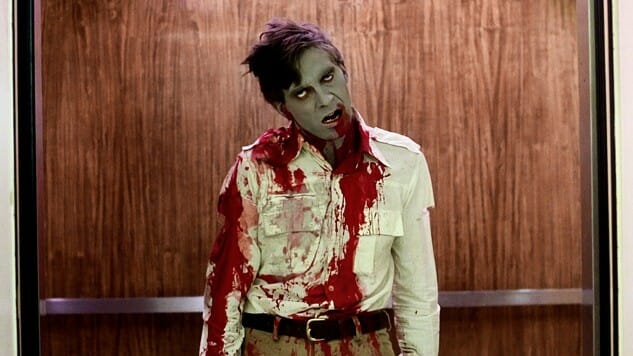
Where Night of the Living Dead is rough, fuzzy and decidedly cheap-looking, Dawn of the Dead makes a giant leap forward in terms of presentation, professionalism, thematic complexity and groundbreaking special effects. It took Romero 10 years to get his first sequel off the ground, but he ups the ante in every way possible. The plot is more engaging and smartly satirical, with anti-consumerism themes that become apparent as a crew of survivors hole up in a tacky mall overrun by the walking dead. The zombies flood in, not specifically to chase the survivors but to simply wander, as the character speculate that something has compelled them to return to a location that was “important to them in life.” Special effects wizard Tom Savini turns in his first really great adventure in gory experimentation, raising the bar for everyone else who ever wanted to explode a zombie head on screen in the years to come. Dawn is often cited as the all-time greatest zombie film, and although I could make an argument for a few others in the top 10, it’s hard for any of them to compete with it in terms of sheer iconic imagery. The violence is rather gleeful, but the sobering reality of the collapse of civilization contains a nihilistic streak common to zombie apocalypse films, and strikes a balance. Even more than NOTLD, this film sets a specific tone that future zombie films attempted to either duplicate or subvert. Where zombie films from 1968-1978 attempted to capture the aesthetic of NOTLD, nearly every zombie movie since 1978 has made some attempt at channeling Dawn. —Jim Vorel
Jim Vorel is Paste’s resident horror guru. You can follow him on Twitter for much more film content.